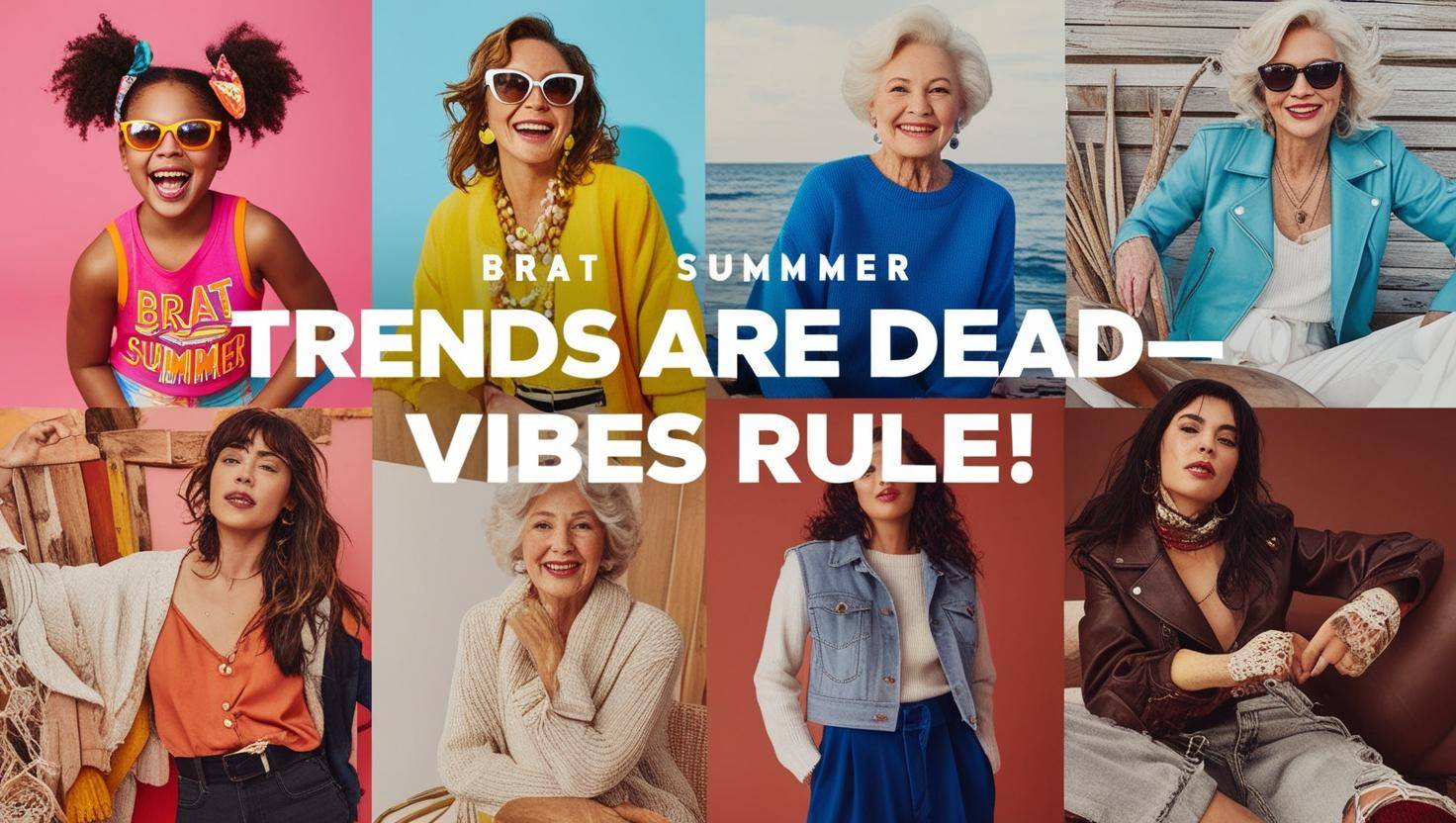Introduction
The world of fashion and culture has witnessed a seismic shift in 2024. No longer are people chasing fleeting micro-trends that last for just a few weeks before fading into obscurity. Instead, a new phenomenon has taken over—the rise of ‘vibes’ over micro-trends.
Unlike micro-trends, which focus on specific styles or products that gain sudden popularity on social media, vibes encompass entire aesthetics, emotions, and lifestyles. One of the biggest examples of this shift is ‘Brat Summer,’ a movement blending music, fashion, and attitude into a cohesive ethos.
This shift is not just about clothes—it reflects a broader change in how people express themselves, moving toward more meaningful, community-oriented identities. In this article, we will explore how this trend emerged, its cultural impact, and why it represents a more sustainable, authentic approach to personal style.
The Death of Micro-Trends: Why Fast Fashion is Fading
For years, micro-trends dominated platforms like TikTok, Instagram, and Pinterest. Fast fashion brands capitalized on these fleeting styles, churning out cheap, trendy clothes that would be irrelevant in just a few months. The cycle was simple:
A celebrity or influencer wears something unique.
Fast fashion brands replicate it instantly.
Social media users rush to buy and showcase the style.
Within weeks, a new trend emerges, making the previous one ‘uncool.’
However, by 2024, consumers grew exhausted by this rapid cycle. Many began to reject micro-trends for a variety of reasons:
Sustainability concerns – Fast fashion contributes massively to pollution and waste.
Burnout – Keeping up with constantly shifting trends became overwhelming.
Desire for individuality – People wanted to create unique styles rather than blindly following trends.
This exhaustion paved the way for the rise of vibes—a more relaxed, personal, and expressive way of engaging with fashion and lifestyle.
 A side-by-side comparison of fast fashion micro-trends from 2022–2023 vs. the slower, aesthetic-driven styles of 2024.
A side-by-side comparison of fast fashion micro-trends from 2022–2023 vs. the slower, aesthetic-driven styles of 2024.
What Are ‘Vibes,’ and How Are They Different?
A vibe is a broader aesthetic that influences multiple aspects of a person’s life—fashion, music, activities, and even social interactions. Unlike micro-trends, which focus on single items (e.g., a specific dress or shoe style), vibes are holistic.
For example, the ‘Brat Summer’ vibe isn’t just about wearing certain clothes; it’s about embracing a confident, rebellious attitude, listening to specific music (hyper-pop, punk influences), and engaging in carefree summer activities.
Other examples of vibes that have gained traction include:
Coastal Grandma – Soft, beachy aesthetics with an emphasis on comfort and nostalgia.
Y2K Revival – A mix of early 2000s influences but with a modern, personalized touch.
Indie Sleaze – A return to the grunge-inspired, Tumblr-era fashion and lifestyle.
Each of these ‘vibes’ creates a sense of belonging rather than just dictating a passing fashion choice.
The Role of Social Media in the Shift to ‘Vibes’
Social media platforms like TikTok have played a crucial role in moving the conversation away from short-lived trends to longer-lasting aesthetic movements.
Here’s how platforms contributed to this change:
1. Algorithmic Evolution
In 2023, TikTok and Instagram started prioritizing evergreen content—longer-lasting styles, aesthetics, and cultural themes rather than quick, disposable fashion.
2. Creators Emphasizing Personal Style
Many influencers stopped promoting mass-produced fast fashion hauls and instead focused on curating personal wardrobes. The ‘capsule wardrobe’ and slow fashion movements gained traction as creators encouraged followers to find their own styles.
3. Community Engagement
Vibes encourage people to participate in a lifestyle rather than just buy a new outfit. Instead of just purchasing a viral item, people now adopt an entire aesthetic, from music choices to weekend activities.
 Viral TikTok showcasing the transition from micro-trends to long-term aesthetics like ‘Brat Summer’ and ‘Coastal Grandma.’
Viral TikTok showcasing the transition from micro-trends to long-term aesthetics like ‘Brat Summer’ and ‘Coastal Grandma.’
The Cultural Impact of ‘Vibes’
The shift to vibes over micro-trends has had a significant impact on fashion, sustainability, and personal identity.
1. Fashion Becomes More Individualized
Instead of following rigid trends, people now mix and match elements from various aesthetics to create something uniquely their own. This has led to:
More creative fashion choices
A resurgence of vintage and thrift shopping
Increased DIY culture (customizing clothes, up cycling old pieces)
2. More Sustainable Consumer Habits
With fewer people chasing fast fashion, there has been a noticeable decline in overconsumption. Instead of buying a whole new wardrobe every season, people are investing in timeless pieces that align with their chosen ‘vibe.’
3. A Stronger Sense of Identity
Vibes allow people to express their personalities through multiple aspects of their lives. Instead of just dressing a certain way, people now adopt an entire lifestyle that feels authentic and long-term.
Will ‘Vibes’ Last, or Is This Just Another Trend?
While some critics argue that ‘vibes’ will eventually fade like any other movement, there’s strong evidence that this shift is here to stay.
People are exhausted by fast fashion and constant trend-chasing.
There’s a growing demand for sustainability in the fashion industry.
Social media algorithms now favor more personal, aesthetic-driven content.
If anything, the focus on vibes will continue evolving rather than disappearing. New aesthetics will emerge, but rather than being temporary fads, they will integrate into people’s identities, making them more lasting.
 A collage of different ‘vibe’ aesthetics, showcasing how people mix and match styles to create unique looks.
A collage of different ‘vibe’ aesthetics, showcasing how people mix and match styles to create unique looks.
Conclusion: The Future Belongs to Authenticity
The shift from micro-trends to vibes represents more than just a change in fashion—it’s a cultural transformation. People are rejecting short-lived trends in favor of long-term personal aesthetics that reflect who they truly are.
By focusing on expression over consumption, the rise of vibes signals a more sustainable, meaningful, and creative future in fashion and lifestyle.
Key Takeaways:
âœ”ï¸ Micro-trends are fading due to sustainability concerns and burnout.
âœ”ï¸ â€˜Vibes’ focus on entire lifestyles rather than single trendy items.
âœ”ï¸ Social media is fueling this shift by promoting personal aesthetics over fleeting trends.
âœ”ï¸ This movement encourages sustainability, creativity, and individuality.
As we move forward, one thing is clear: the future of fashion isn’t about following trends—it’s about creating your own vibe.


